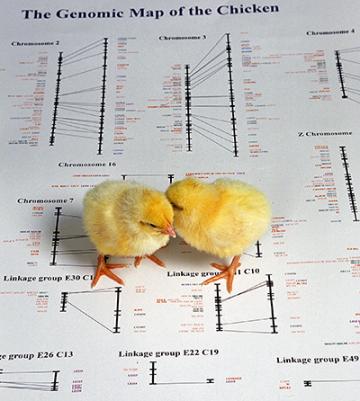Defending Against Marek’s Disease with Genetics and Epigenetics

Chicks atop a picture of a genetic map of a chicken. The chicken genome will make it easier to locate genes, especially those for complex traits like disease resistance. (Photo by Peggy Greb)
Poultry is the world’s most consumed meat. This popular food choice is also squarely in the crosshairs of Marek’s disease, a foe with a mortality rate that is typically 10-50% in unvaccinated chickens, but can reach as high 90% in some breeds.
As the second largest exporter of chicken (behind Brazil), U.S. poultry production is big business. According to the National Chicken Council, in 2022 the U.S. poultry industry accounted for more than 1.5 million jobs, nearly $95 billion in wages, and $417 billion in economic activity. The disease, however, takes a tremendous bite out of those numbers – estimated worldwide economic losses from Marek’s disease exceed $2 billion due to poultry meat condemnation, reduced egg production, and vaccination cost.
Currently, poultry producers depend primarily on vaccines to keep their birds safe, but researchers with the Agricultural Research Service (ARS) are working to develop a long-term control strategy that relies on a better understanding of disease resistance through host genetics and epigenetics (how behaviors and environment can change the way genes work).
According to Huanmin Zhang, an animal geneticist with the ARS Endemic Poultry Viral Diseases Research unit in Athens, GA, “that fundamental understanding could guide us to develop more potent vaccines for better disease control.”
Marek’s disease is a highly contagious viral disease that causes tumors in chickens and is caused by a version of the herpes virus. Its clinical signs vary from bird to bird, but commonly include premature death, paralysis of the legs, wings, and/or neck, weight loss, loss of appetite, reduced vision, irregular pupils, and tumors in various tissues. The disease is spread among bird populations through both direct and indirect contact. Direct contact includes bird-to-bird aerosols and secretions, while indirect contact involves contaminated material, such as poultry dust and dander from shed Marek’s disease-concentrated feather follicles.
The disease is not contagious to humans.
“The genomics group is [working] to identify genetic and epigenetic factors that modulate genetic resistance to Marek’s disease and to advance the fundamental understanding of how those factors interact with the viral infection process and vaccination process,” Zhang said. “An understanding of the underlying mechanisms will help researchers develop more efficient strategies to establish disease resistance in lines of chickens through selection and breeding. Much more potent vaccines could also be designed to protect all lines of chickens, instead of just some.”
One of the project’s accomplishments was developing a pangenome of the domestic chicken, in collaboration with research partners at Washington University School of Medicine in St. Louis, MO. A pangenome is the entire set of genes from all chicken breeds that descended from a common ancestor. Information from the pangenome can show researchers where the DNA sequences from different breeds are identical or different.
“The pangenome paves the way to discover what effects genetic variants have and make breeding for disease resistance more readily possible in chickens,” Zhang explained.
Reaching the goal of containing, controlling, or mitigating the Marek’s disease depends on the work of the world research community and advances in biotechnology. Zhang noted that advances in understanding and controlling the disease have been greater during the last two decades than the previous 50 years. – by Scott Elliott, ARS Office of Communications

